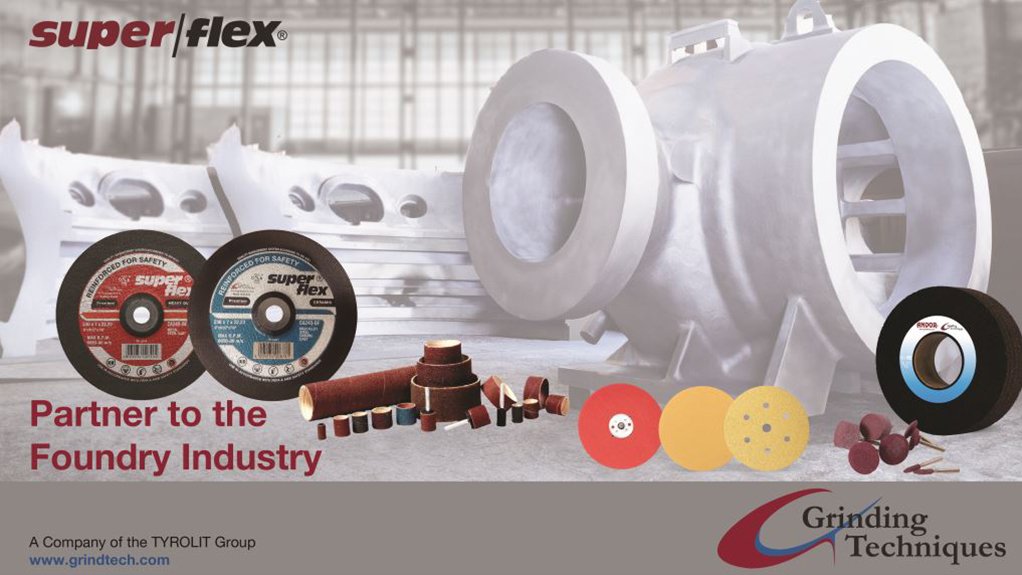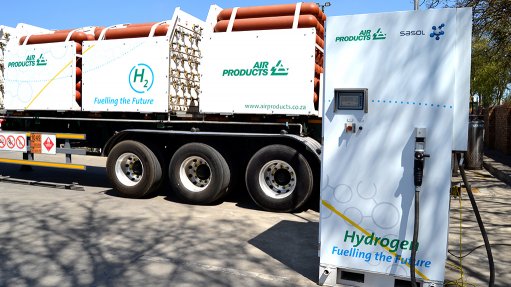Grinding Techniques remain the partner of choice for the Foundry Industry
This article has been supplied as a media statement and is not written by Creamer Media. It may be available only for a limited time on this website.
Since the beginning of time, man found value in utilising various materials for the production of products related to self-sustainability. These materials evolved over time as technology and knowledge increased. From the humble beginnings of the copper age to the current highly sophisticated alloy age, casting of materials in usable forms and shapes remain a critical function.
The oldest metal casting known to man is believed to be a frog casting in Mesopotamia around 3200 BCE. It was the first cast product to show the forming of a mould prior to casting the molten metal.
The bronze age was the era where tin and copper were mixed in the melting process, the new metal was developed in Turkey, Iran and Iraq. It was however the Egyptians that really perfected this process to a fine art and produced many a weapon and other industrial appliances, dominating the bronze age.
With the iron age that followed, the Chinese mastered the art of metal casting and the systematic production of metals around 1000 BC. They managed to mass produce cast tools and farming equipment and the world’s first canons and gun powder. Along with the change in metal production came the changes in the agricultural, religious and cultural spectrums. Europe was only able to produce its first iron products 1000 years later.
After the iron age, the industrial age followed. This era was known as the age of the technical revolution. The demand for cast products was on the rise, and soon new machines were developed to keep up with mass production and demand. Products now casted would include machine components, engine components, rail equipment, equipment for the airplane industry, and a vast array of other consumer goods.
Through the evolution of castings, the basics still remained the same; make the mould, melt the metal, cast, cool and finish off.
As the science of metallurgy has grown in the past three hundred years, so too has the methods used to machine and shape the relevant products. In ancient times, sand stone was used to “file” the relevant pieces. Eventually bigger grinding stones were mounted on hand turned machines to grind and sharpen products. Today we have Ceramicists and Bio-chemical Engineers developing bonding systems for new artificial abrasive minerals being created. Machines that run at speeds exceeding 100m/s and achieving metal removal rated higher than ever before, whilst maintaining form accuracy to literally micron tolerances. Alloys are now being developed to be harder than glass, but still maintain the toughness synonymous with steel and metal related products.
As alloys have become more sophisticated in design and application, so too has the grinding tool required to form and shape the metals being produced. The development of new complex abrasive grains and bonding systems, accompanied by the development of new machines have become the new focal point in the abrasive industry.
Grinding Techniques – a Tyrolit Swarovski company is uniquely positioned to offer application-based solutions. With more than 138 combined years of experience in manufacturing abrasive tools, both Tyrolit and Grinding Techniques are able to offer a comprehensive range of specialised products.
The product range for a typical foundry application includes, but is not limited to:
- Hand Program (cutting and grinding discs)
- Vitrified Grinding Wheels & Segments (precision grinding wheels, bench grinding wheels, laboratory surface grinding wheels, toolroom wheels)
- Resin Bonded Wheels & Segments (swing-frame and pedestal grinding wheels)
- Mounted Points, and Bullnose Cones
- Tungsten Carbide Burrs
- Water and Cabinet Paper Sheets
- Flap Discs
- Fibre Discs
- No Centre Hole Discs
- Bobbin Sleeves – Also known as even-run or spiral bands
- Velcro Discs
- Grinding Belts
- Diamond & CBN Precision Grinding Wheels
- Diamond Discs
- Wire Wheels & Brushes
Our ability to manufacture custom made products to assist in optimising your fettling processes, is unrivalled in the industry today. Our understanding of metallurgy and equipment has propelled us to a become leading role player in the Foundry Industry. Our new innovative Premium Ceramic and Zirconia products are a prime example of market leading technology.
We offer an optimization service that allows for scientific comparison in all aspects of the grinding tool process from the material removal rate, to tool life comparisons and heat generation.
With one of the most comprehensive product ranges available in the Southern African market today, it is no wonder Grinding Techniques is the Industry partner of choice when it comes to the Foundry Industry.
Comments
Press Office
Announcements
What's On
Subscribe to improve your user experience...
Option 1 (equivalent of R125 a month):
Receive a weekly copy of Creamer Media's Engineering News & Mining Weekly magazine
(print copy for those in South Africa and e-magazine for those outside of South Africa)
Receive daily email newsletters
Access to full search results
Access archive of magazine back copies
Access to Projects in Progress
Access to ONE Research Report of your choice in PDF format
Option 2 (equivalent of R375 a month):
All benefits from Option 1
PLUS
Access to Creamer Media's Research Channel Africa for ALL Research Reports, in PDF format, on various industrial and mining sectors
including Electricity; Water; Energy Transition; Hydrogen; Roads, Rail and Ports; Coal; Gold; Platinum; Battery Metals; etc.
Already a subscriber?
Forgotten your password?
Receive weekly copy of Creamer Media's Engineering News & Mining Weekly magazine (print copy for those in South Africa and e-magazine for those outside of South Africa)
➕
Recieve daily email newsletters
➕
Access to full search results
➕
Access archive of magazine back copies
➕
Access to Projects in Progress
➕
Access to ONE Research Report of your choice in PDF format
RESEARCH CHANNEL AFRICA
R4500 (equivalent of R375 a month)
SUBSCRIBEAll benefits from Option 1
➕
Access to Creamer Media's Research Channel Africa for ALL Research Reports on various industrial and mining sectors, in PDF format, including on:
Electricity
➕
Water
➕
Energy Transition
➕
Hydrogen
➕
Roads, Rail and Ports
➕
Coal
➕
Gold
➕
Platinum
➕
Battery Metals
➕
etc.
Receive all benefits from Option 1 or Option 2 delivered to numerous people at your company
➕
Multiple User names and Passwords for simultaneous log-ins
➕
Intranet integration access to all in your organisation





















